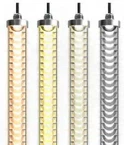Common types of fittings in transmission lines include:
Insulator String Fittings: Used to connect insulator strings to conductors, as well as to connect insulator strings to support structures or suspension equipment. Insulator string fittings include suspension rings, suspension chain, suspension ring shoulders, suspension ring pins, and insulator string shoulders.
Conductor Fittings: Used to connect, secure, and insulate the conductors in transmission lines. There is a wide variety of conductor fittings, including preformed guy grips, compression connectors, insulating clamps, and line clamps.
Insulator Fittings: Used to connect insulators to support structures or suspension equipment and to secure insulator strings in their positions on the transmission line. Insulator fittings include insulator bending hoops, insulator clamps, insulator string fasteners, and more.
Ground Wire Fittings: Used to connect the grounding wires of the transmission line, ensuring a proper grounding connection for safety protection. Ground wire fittings include ground wire clamps, ground wire dead-end clamps, and more.
Insulator String Splice Fittings: Used to splice insulator strings together, creating the appropriate length to meet specific line requirements. These fittings typically include insulator string splice rings, splice chains, splice shoulders, and others.
Suspension Equipment Fittings: Used to suspend the transmission line from support structures, maintaining the proper height and position of the line. These fittings encompass suspension rings, suspension chain, suspension ring shoulders, and more.
Tower Connection Fittings: Used to connect various components of transmission towers, ensuring their stability and safety. These fittings include bolts, nuts, connecting plates, and more.
These fittings play vital roles in the construction and maintenance of transmission lines. They not only connect and secure different parts of the lines but also ensure the normal operation and safety of the lines. Different types of fittings have distinct applications in transmission lines based on their purposes and characteristics.







